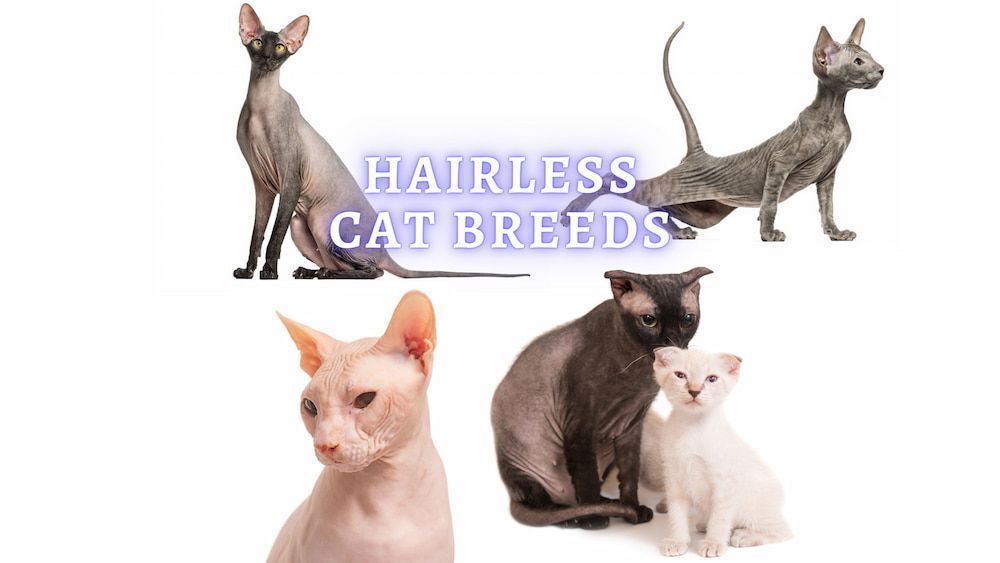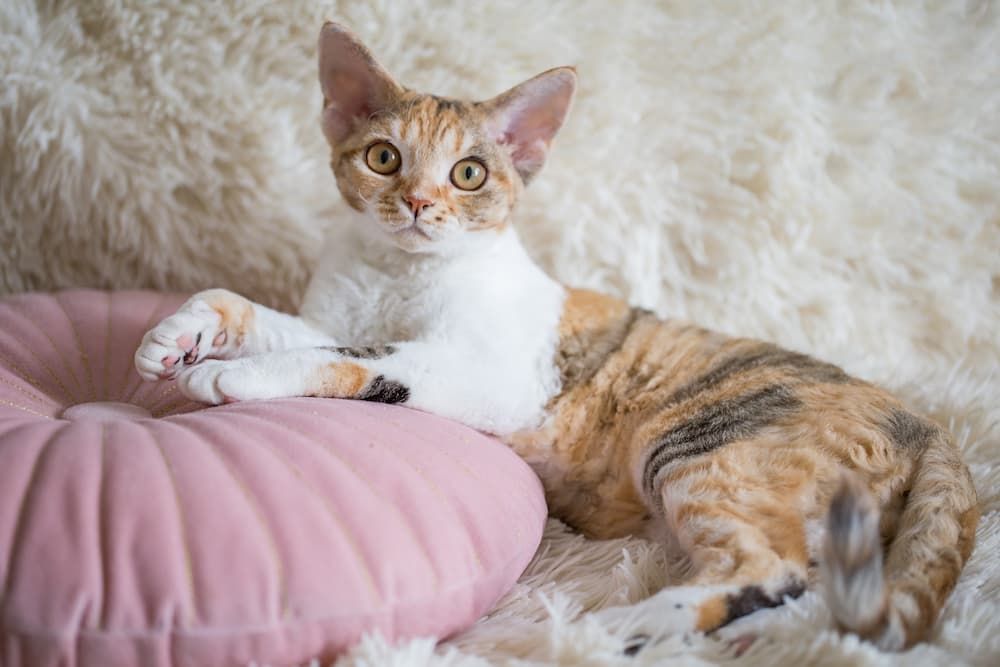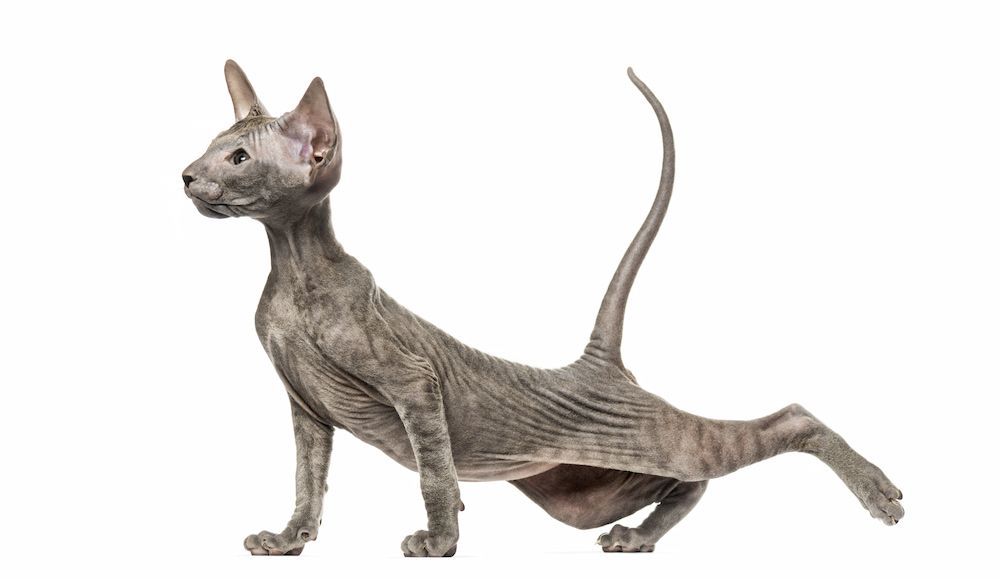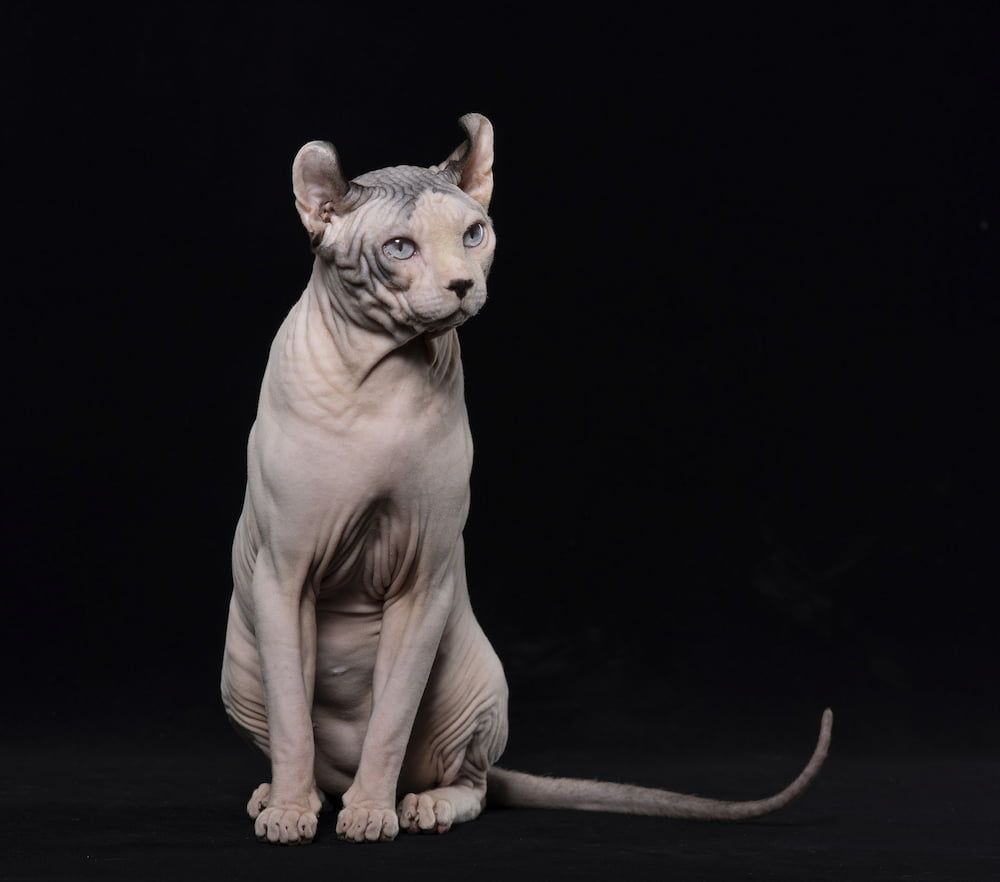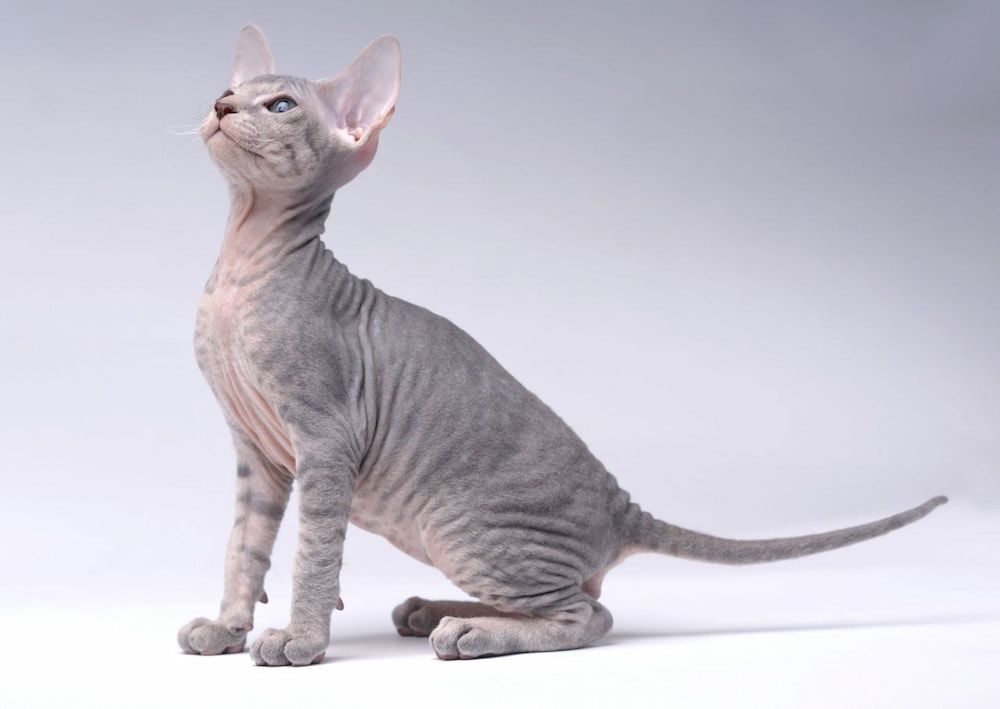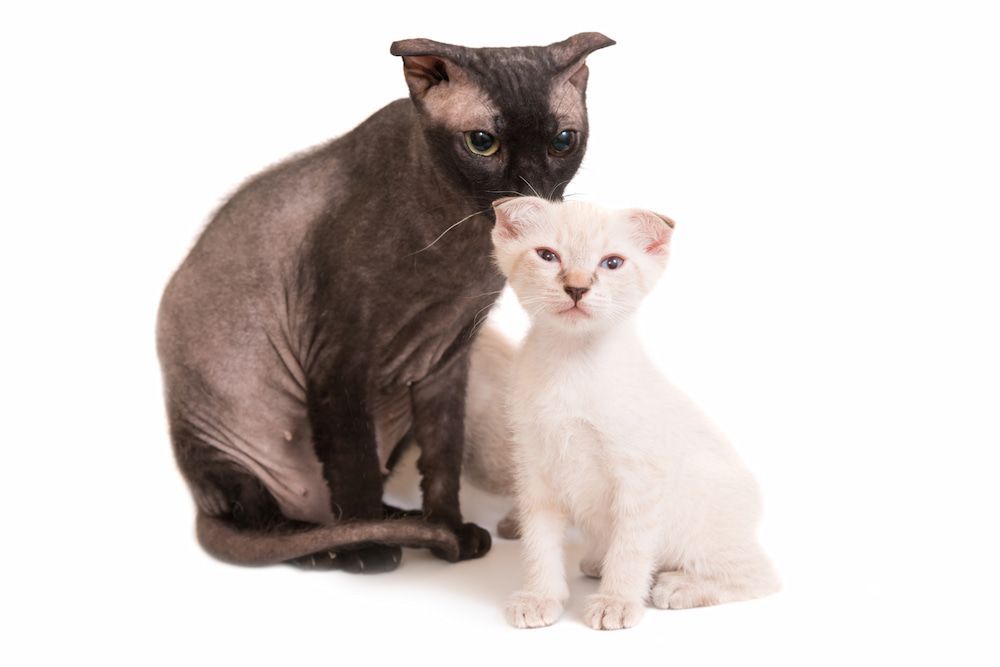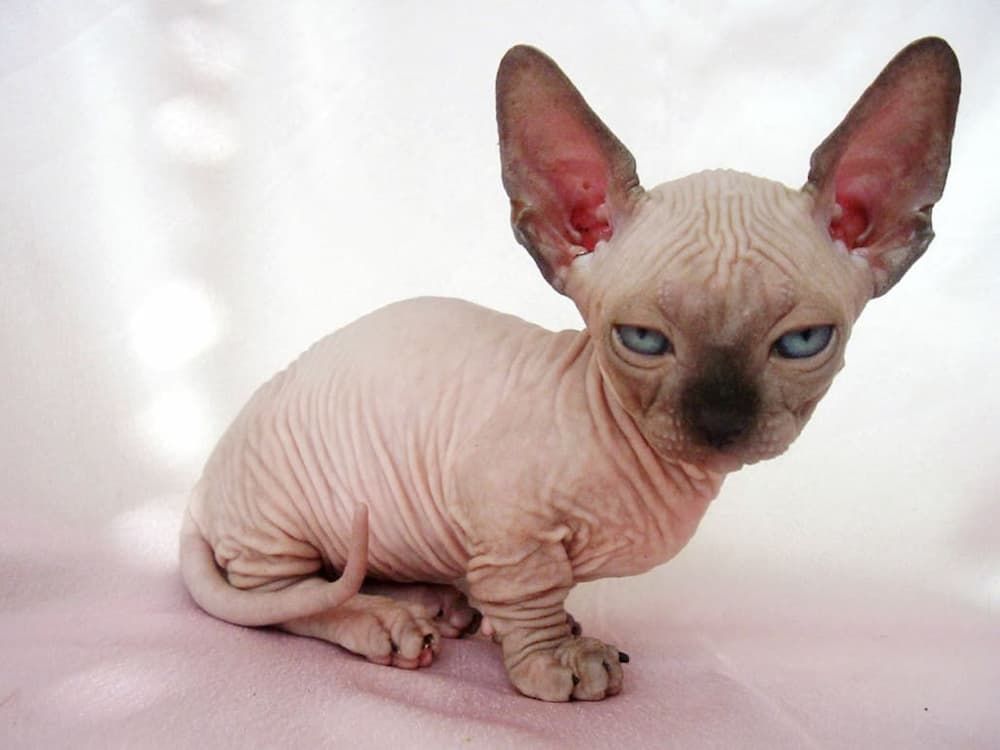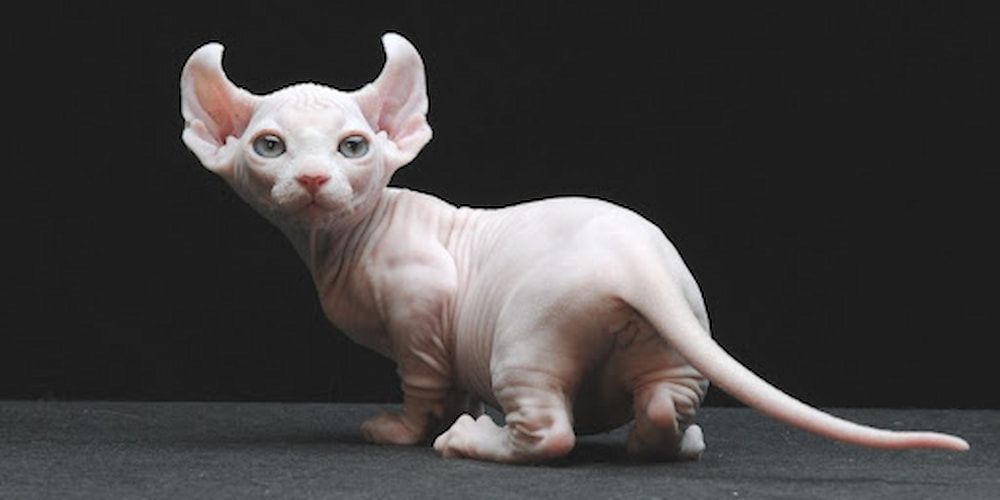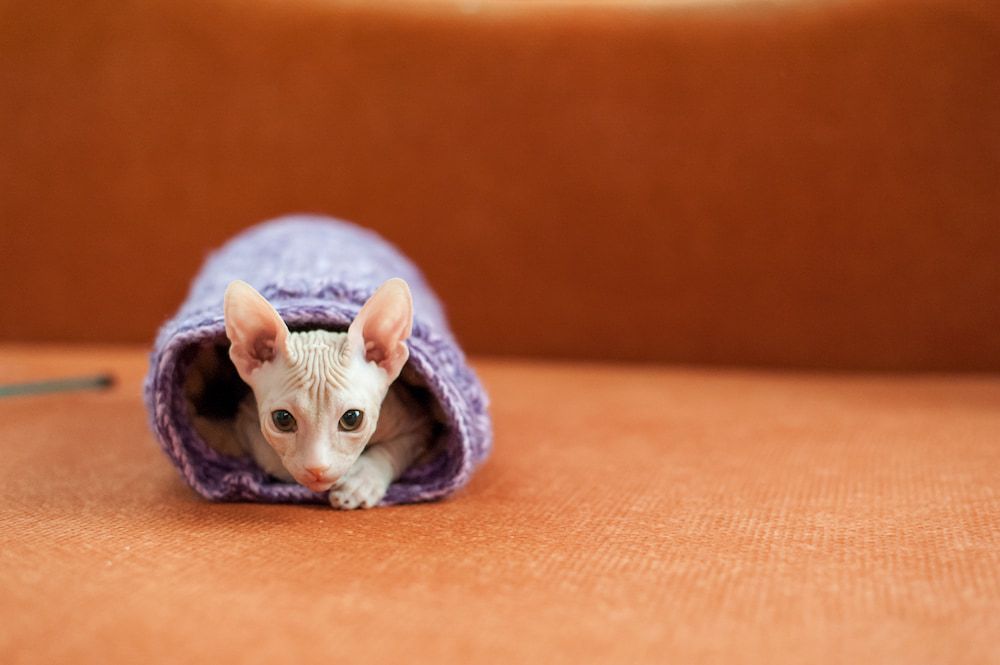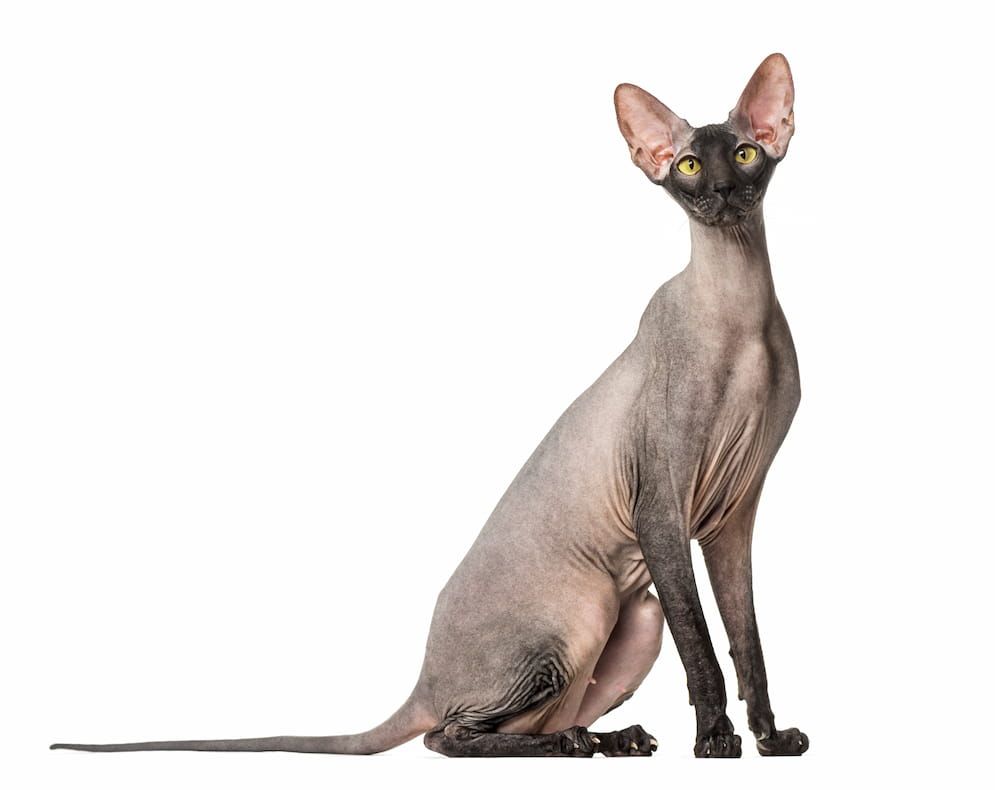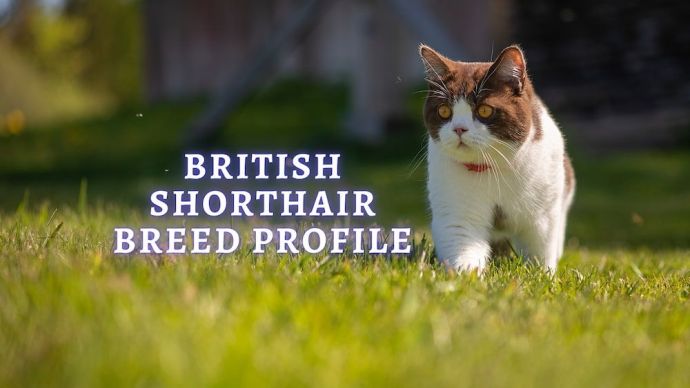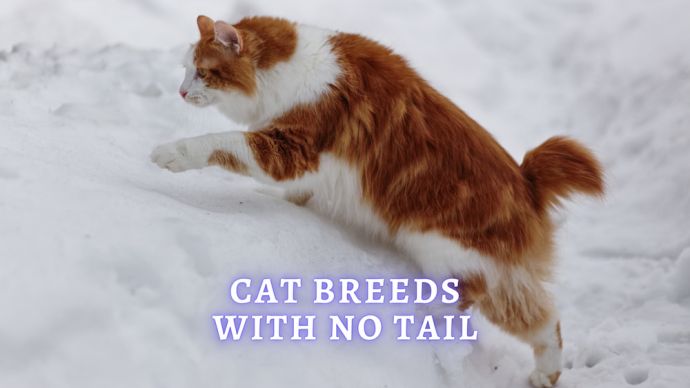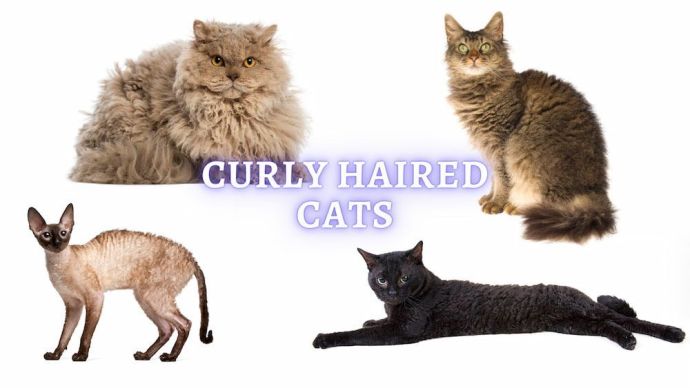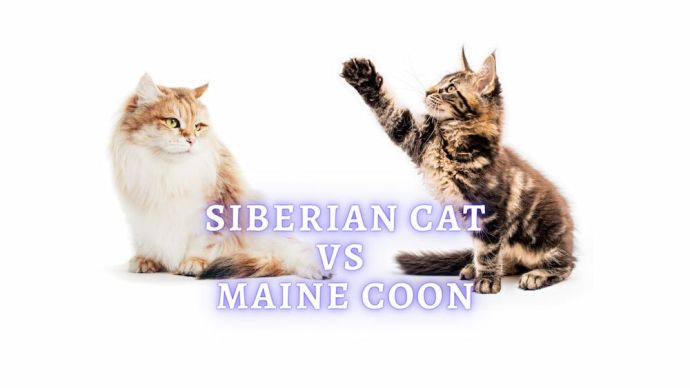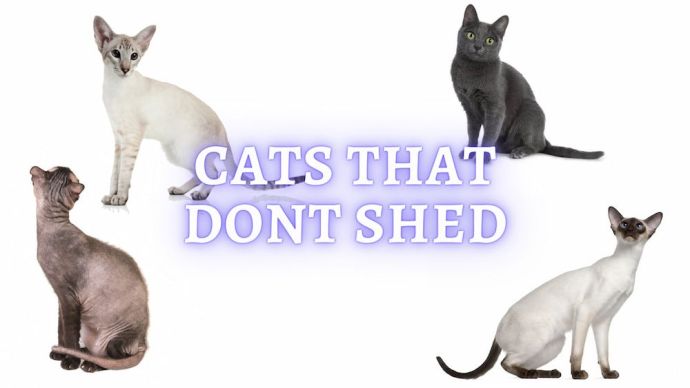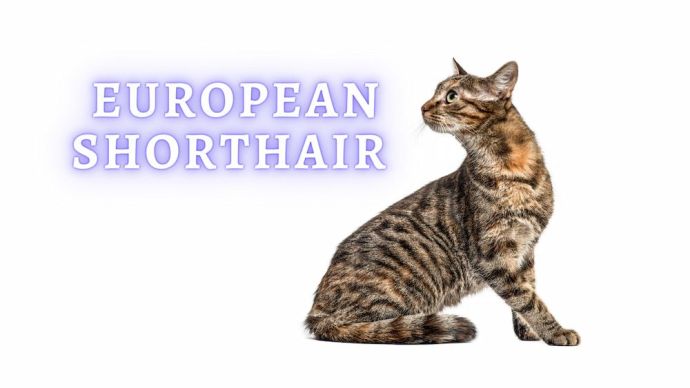Hairless Cat Breeds: 10 Breeds of Hairless Cat
Written by:
Author: Carol Young
Carol has worked in specialty, emergency, mixed animal and general veterinary practices, and enjoys all aspects of veterinary medicine. Her special areas of interest include anesthesia, critical care, emergency, dentistry, internal medicine and small animal nutrition.
View all 62 articlesLearn about our editorial process and veterinary review board.
Viewed: 122
Updated on: 07/06/2023
When most of us think of cats, we think of furry, cuddly little creatures. However, hairless cats can be just as cuddly and affectionate without the added hair and dander. Hairless cats have been around for a very long time and go as far back in history as the period of the Aztecs in Central and South America. Some hairless breeds, such as the Sphynx, look like they may have been royal cats of the Egyptian pharaohs, but they didn’t appear on the cat scene until the 1960s.
In the early 2000s, hairless cats became more popular, and breeders sought to develop new breeds, such as the Sphynx and the Devon Rex. Hairless cat breeds are unique in appearance and are known to be very affectionate and friendly with people and other pets. If you are interested in adding a hairless cat to your home, there are some things that you want to know before you adopt or purchase one of these exotic felines.
Are hairless cats hypoallergenic?
Hairless cats have hair (some more than others), which means that they may not be hypoallergenic, but they can be a good choice for owners allergic to cat dander. Almost all hairless breeds have some hair, either on their tails or between the toes, and some cats are born with a certain amount of hair and then gradually go bald.
The shorter coats or lack of fur make allergy sufferers easier. Still, it’s essential to know that people who are allergic to cats are not allergic to their hair but rather to allergens contained in a cat’s saliva. The good news with hairless cats is that they have less fur, so they shed and lick their fur less than a cat with a full coat of hair.
A hairless breed may be a good choice if you are allergic to cats and would like to add a cat to your home. Allergy sufferers can be less sensitive to hairless cats and won’t have to worry about a lot of shed hair that can get stuck on carpets, furniture, or clothes.
List of Hairless Cat Breeds
There are many hairless cats, and some have been approved by international cat breeding associations such as TICA (The International Cat Association) and the Cat Fanciers’ Association. Each breed has its own set of unique characteristics, and these characteristics can help you decide what variety is a good fit for you and your home. Some hairless breeds are small and significant for apartment living, while others can be large, up to 14 pounds. Each breed has a unique appearance; most have trademark pointy or curled ears and lean bodies. Also, a few of the cats listed below have small amounts of hair, so you can find a balance between a more allergen-friendly feline companion and one with a little bit of hair.
1. Sphynx
The Sphynx, or the Canadian Sphynx, is perhaps the best-known breed of hairless cat. First developed in Canada in the 1960s, this breed is known for its mischievous and outgoing nature and loves to cuddle with its humans. They are also typically vocal and talkative, intelligent, and affectionate.
The Sphynx is perhaps known as the typical hairless cat, but it isn’t totally hairless, just nearly hairless. The hair coat of this sleek and muscular breed can range from completely bald to peach fuzz and comes in various colors such as black, cream silver, and tortoiseshell. Coat patterns range from solid, bicolor, tabby, and shaded smoke.
The head of the Sphynx is triangular, with wide-set eyes and prominent cheekbones that make them look like the cats of ancient Egypt (hence its name). Apart from being entire to almost hairless, the Sphynx’s most characteristic feature is the giant, triangle-shaped “bat” ears.
Males and females weigh between six and 12 pounds and stand eight to ten inches tall. Since this breed is virtually hairless, no brushing is needed; however, regular bathing may be needed to keep its coat clean and healthy.
READ MORE: All About Sphynx Cat
2. Devon Rex
The Devon Rex cat is a tall-eared, curly-haired breed that emerged in Britain in the late 1950s. This breed is often thought of as one of the most hypoallergenic cats around; however, it is not technically hypoallergenic as it does have patches of curly, soft fur in areas around the head and shoulders. The head of the Devon Rex is triangular, the eyes are significant, and the ears are large and set low on the head with a broad base. The butterfly shape of the ears gives this breed an elf-like look. This variety comes in a wide selection of colors and patterns, ranging from white, black, tabby, and tortoiseshell, and the eye color varies from aqua to copper. Males and females tend to be small, weighing under eight pounds and standing ten to twelve inches tall.
The Devon Rex is an affectionate as well as an active, energetic breed, so be prepared for a lot of playtime. This breed also likes to jump, so cat trees and perches should be provided for proper exercise and entertainment. Although the Devon Rex has little hair, it does require some grooming, but should never be brushed because its fur is fragile. As a result, grooming should be done with a cloth or towel.
READ MORE: Curly Haired Cat Breeds
3. Lykoi
The Lykoi, also known as the “werewolf cat” or the “wolf cat” due to its resemblance to a wolf, is considered a hairless breed but can be covered entirely in hair to partially hairless. This breed is characterized by a wedge-shaped head, big, wolf-like ears, and large golden eyes. The hair coat is quite soft, often having a roan pattern, and white hairs can be scattered throughout the coat. Lykoi cats are often more haired than others and can range from fully haired to almost bald. The Lykoi does not have much of an undercoat except around the feet, nose, and eyes.
The Lykoi is a small- to a medium-sized cat, with both males and females weighing about six to twelve pounds and standing eight to ten inches tall. This variety is known to be affectionate, loving, and friendly towards humans and other pets. Physical characteristics include a lean and strong body build, short tails, and medium-sized legs relative to their body size.
Lykoi cats can be quite energetic, and due to their genetic heritage shared with feral cats, often have a strong prey instinct. They enjoy stalking toys, other small pets, and even people at times. Although they may at first be cautious when placed in new situations, they will in time warm up to both people and other pets.
4. Elf
The Elf cat is a rare hybrid derived from the Sphynx cat and the American Curl and is known for its virtually hairless body and large, curled ears. Although the Elf cat is hairless, you won’t need to worry about shedding, but like other hairless breeds, can still produce dander.
The Elf cat can come in a variety of colors, such as beige, pink, black, or gray, and the eyes can come in any color. Males and females range from ten to fifteen pounds and stand between thirteen and fifteen inches tall. They are known to be very sociable and intelligent and get along with other household pets.
Since the Elf cat is mostly hairless, grooming with a brush is unnecessary, but the skin needs special attention, including wiping the cat’s skin down to remove oily secretions and bathing regularly.
RELATED: Rare Cat Breeds
5. Donskoy
The Donskoy cat, also known as “Don Sphynx” or “Russian Hairless,” is a hairless breed that first emerged in Russia. The Donskoy is a muscular breed that ranges from hairless to some hair with bald spots. They’re notably intelligent, loyal, friendly, and active cats who love attention and spending time with their humans.
Males and females can weigh between six and fifteen pounds, stand between thirteen and fifteen inches tall, and come in many colors and coat patterns. The Donskoy is considered a medium-sized cat with a muscular build, velvety, wrinkled skin, and a well-rounded belly. They have broad, large ears, almond-shaped eyes, and long, slim toes separated by webbing.
The Donskoy is an affectionate, good-natured breed, making it a good choice for families with children and other pets. Since they are social and most happy interacting with people, it’s best not to leave them alone for long periods.
6. Peterbald
Like the Donskoy, the Peterbald originated in Russia in the 1990s and is a mixed breed cat created by crossing an Oriental Shorthair and a Sphynx cat. Peterbalds are known to be loyal, sweet, and affectionate, and with just about anyone, including other pets and children.
This variety is a carrier of a hair-loss mutation which results in either a velour, bald, “brush,” straight, or flocked hair coat that comes in a variety of colors and patterns. The brush fur pattern is unique to the Peterbald, and this type of fur is short and wiry.
Peterbald cats are often born hairless or born with a hair coat that can change in texture and length as the cat ages. These cats resemble the Oriental Shorthair in their slim stature, muscular build, almond-shaped eyes, and large, pointed ears.
The Peterbald ranges in weight from seven to fourteen pounds and stands up to twelve inches in height. The Peterbald may be a great choice if you are looking for a loving, affectionate, relatively hypoallergenic, and loyal family pet.
READ MORE: All About Peterbald Cats
7. Ukrainian Levkoy
The Ukrainian Levkoy cat came on the cat scene in 2004 and is named after the Levkoy plant found in Ukraine. The Levkoy cat’s ears are folded and resemble the folded leaves of the Levkoy plant, and the breed is a result of crossing a Scottish Fold with a Donskoy.
Most Ukrainian Levkoy cats have light, downy fur, so they are not completely hairless. They are known for their short noses, long and angular-shaped heads, and wrinkled skin between the ears. The profile should be “stepped” like a dog’s face. The eyes are typically almond-shaped, and they come in a variety of colors and patterns.
The Ukrainian Levkoy is smart, playful, affectionate, and gets along well with people and other pets. Males and females range in weight from eight to twelve pounds and stand from eight to ten inches tall. This breed loves to explore, so be prepared to find them in some unexpected places.
8. Minskin
Like most hairless cat breeds, the Bambino is a hybrid cross between a Sphynx and a Munchkin cat, giving it the appearance of a Sphinx with very short legs. This breed is very affectionate, playful, and energetic, and its smaller stature makes it a good fit for apartment living.
The Bambino comes in various patterns, such as solid or bicolor, and comes in black, white, brown, fawn, or cream colors. One of the interesting aspects of this breed is that they have only one eye color: Blue. The Bambino is small, with males and females ranging in weight from five to nine pounds, and are smallish in height, standing from seven to eight inches high.
This small to medium-sized hairless breed loves to play but doesn’t need a lot of exercises. Because it is hairless, the Bambino does not shed and does not require any brushing, only regular bathing, and grooming with a towel or a soft grooming glove.
9. Dwelf
Another hairless breed is the Dwelf, which looks like a dwarf elf cat. It originated by crossing an Elf, an American Curl, and a Munchkin. It sports the round and curved ears of the Elf while and the short legs of the Munchkin.
As with most hairless breeds, the Dwelf isn’t totally hairless but does have a velvety hair coat that looks and feels a lot like peachfuzz. This breed comes in various colors and patterns, and eye colors range from brown to blue. The Dwelf is a small breed, weighing between four to nine pounds, and standing six to seven inches tall.
Dwelfs are playful, active, and almost dog-like in terms of their social and friendly nature. So, if your family is looking for a hypoallergenic feline friend, the Dwelf can be a great choice.
READ MORE: All About Dwelf Cats
10. Sphynx Hybrids
Although all hairless cats are essentially hybrids, currently, breeders are looking to cross the hairless mutation in sphynx cats to produce new hybrid types. For example, in 2015, a new hybrid called the “Sphynxiebob” was created by crossing a Sphynx with an American bobtail. Also, the Elf cat is a Sphinx hybrid as well, a combination of the Sphynx and the American curl.
No matter the combination, most Sphynx hybrids are virtually hairless and do not shed.
How to Care for Hairless Cats
How do you groom hairless cat breeds?
Grooming hairless felines understandably does not entail a lot of brushing; however, these fur-free felines do require frequent bathing since their skin is oily and tends to become dry. Since they lack the protective coat of their fuzzy counterparts, hairless cats are more likely to suffer sunburn and are more susceptible to skin allergies.
To ensure healthy skin, hairless cats often require regular bathing at least once a week or once a month, depending on the variety. The reason for this is that the lack of hair results in an overabundance of oils that can trigger skin problems and stain clothes and fabrics. In those types who lack ear hair, such as the Sphynx, ear infections can be common, so regular ear cleaning is important.
Protect Them from the Sun
Because hairless cats lack a protective hair coat, this puts them at risk for sunburn, so it’s always important to protect them from the sun’s rays (including reflected rays). Overexposure to the sun can result in pigmentation marks and skin damage. Since there is no 100% safe pet sunscreen available on the market right now, sun exposure should be very limited.
If you have a hairless cat that likes to sunbathe, try to limit these episodes to a few minutes and only under direct supervision. Almost all kitties like to bask in the sun’s warmth, so try to satisfy this desire by trading the sun’s damaging rays for a pet-safe warming blanket or bed.
Help Them Stay Warm
We all know that fur and hair protect against the cold as well as against the rays of the sun. However, hairless cats don’t have this advantage, so it’s important to ensure that this breed is kept warm and comfortable. Hairless felines are best kept indoors, or inside a cat enclosure that is adequately heated. Some owners even put sweaters and hoodies on their hairless kittens to keep them warm and protect their skin from the sun.
Lookout for Skin and Health Conditions
As mentioned above, sunburn is a real concern for hairless felines, as is oily and dry skin. Limiting sun exposure is a must, and frequent bathing to help remove excess skin oils can keep your hairless cat comfortable. Even though hairless cats have n oily coats, they can also suffer from dry, flaky skin. Again, for this reason, it’s important to bathe and care for the skin regularly.
People also ask
How many types of hairless cats are there?
There are many breeds of hairless cats, and it seems as though new ones are popping up every year. However, there is only one breed of hairless cat that the Cat Fanciers Association recognizes, and that is the Sphynx.
How much does a hairless cat cost?
Because the hairless is an uncommon breed, they can be a bit expensive. If you’re looking to buy a cat such as a Sphynx, you can expect to pay from $1,500-$6,000, depending on the line and pedigree. As always, do your research before purchasing a hairless cat, and make sure that the breeder is reputable and that a veterinarian has checked both parents and kittens.
What kind of cat looks like a Sphynx but has hair?
There are many types of hairless cats, and several look a lot like the Sphynx. One variety, in particular, is the Donskoy cat. The Donskoy does look quite a bit like a Sphynx and shares the Sphynx’s hairless and pointy ear genes.
Article Sources:
- “Hypoallergenic Cat Breeds.” Purina® Canada, purina.ca/cats/cat-breeds/collections/most-hypoallergenic-cat-breeds.
 Cat Care Why Does My Cat Attack My Legs? 10 Reasons Why and What To Do About It (Vet-Approved Advice)
Cat Care Why Does My Cat Attack My Legs? 10 Reasons Why and What To Do About It (Vet-Approved Advice) - 46013
- 21
 Cat Veterinary Tips Cat Stomach Gurgling: Vet Advice on Why is Your Cat Stomach Gurgling?
Cat Veterinary Tips Cat Stomach Gurgling: Vet Advice on Why is Your Cat Stomach Gurgling? - 36469
- 4
 Cat Veterinary Tips My Cat Lost its Voice: Can Cats get Laryngitis? (Vet Advice)
Cat Veterinary Tips My Cat Lost its Voice: Can Cats get Laryngitis? (Vet Advice) - 23554
- 13









